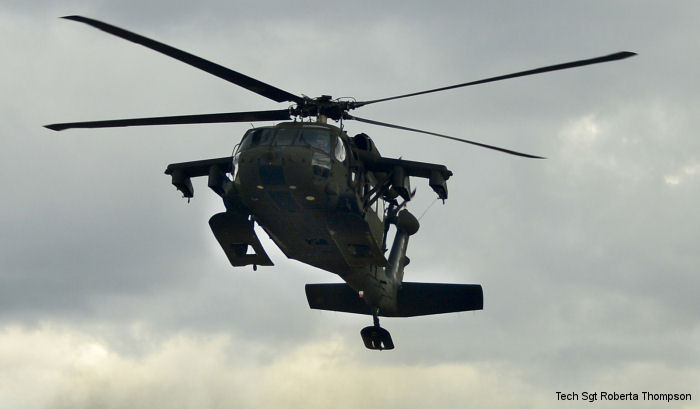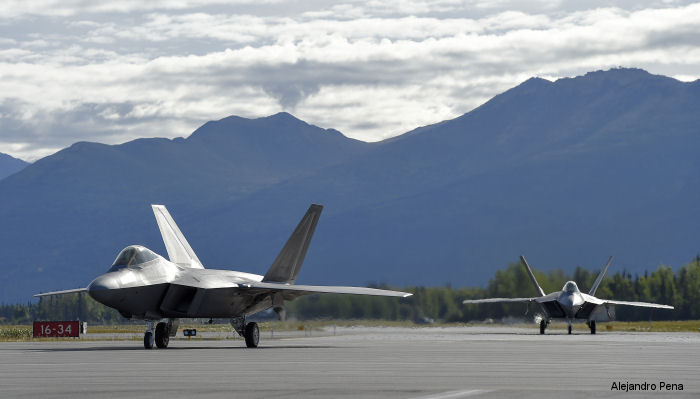US Air Force, August 12, 2015 - JOINT BASE ELMENDORF-RICHARDSON, Alaska -The Alaska Air National Guard’s 176th Wing is playing its most extensive role ever in exercise Red Flag-Alaska, which started last Thursday and is scheduled to continue until Aug. 21.
Conducted three to four times per year, Red Flag-Alaska provides U.S. and partner-nation forces a comprehensive, simulated combat training environment that includes offensive counter-air operations, interdiction, close air support, and large force employment.
This iteration of the recurring exercise, Red Flag-Alaska 15-3, marks the heaviest involvement the 176th Wing has ever seen. All of the wing’s operations units — the 144th and 249th airlift squadrons; and the 210th, 211th and 212th rescue squadrons — are participating.
176th Maintenance Group personnel are also heavily involved, as they maintain the wing’s C-130 Hercules, and HC-130 King aircraft; and the HH-60 Pave Hawk rescue helicopters. They also help maintain C-17 Globemaster III aircraft, which belong to the Air Force, but are operated and maintained by both the Air National Guard and active duty personnel.
“This exercise is a chance for warfighters to practice their first ten sorties in a combat scenario,” said Maj. Kirby Chacon, deputy chief of operations support squadron-tactics, 176th Operations Group, Alaska Air National Guard. “This has always been a combat air forces driven event, so fighters go against adversarial fighters to learn to survive in war.”
According to Chacon, though there has always been a mobility air forces element to the exercise, this iteration of Red Flag has a much heavier involvement from airlift elements of U.S. and partner nations.
“This year, there are 13 C-130s plus two C-17s, which are a significant amount of [mobility] assets for Red Flag,” he said.
Along with the 144th’s fleet of C-130s participating in the exercise, there are also additional C-130s from other U.S. forces and from England, New Zealand, Thailand and Japan.
Chacon said that the training is important, because it provides participants the training to operate within a complex, scenario-driven environment, designed to test their ability to navigate the risks and perils of combat operations.
“It’s unique for the fact that most of what we’ve done for the last ten years or more—yes we’ve been flying combat missions—but typically you don’t have air delivery C-17s and C-130s operating in a threat environment,” he said. “The potential is always there, but to actually practice flying in threats and utilizing fighter coverage is key.”
Aside from the air delivery missions supported by the 144th and 249th airlift squadrons, the 210th, 212th and 212th rescue squadrons are participating in a range of scenarios, including isolated personnel recovery missions, as well as supporting the U.S. Army during an airfield seizure mission.
“There are about four or five personnel recovery events that our rescue squadrons are integrating with A-10s and other fighters out of Eielson Air Force Base for a downed pilot scenario,” said Chacon. “It’s also important because on the fighter side of it, if you have a wingman go down, it’s also valuable training for the them, regardless of whether it’s an A-10 or F-16 or other fighters, because they have to provide the on-scene commander duties. For rescue, it’s good training, because it provides a realistic scenario, because they have to fight to get in and fight to get out after recovering the downed pilot.”
Chacon said that this iteration of Red Flag is significant for the wing because it happens “in our own back yard” and “gives us an element of ownership” of the event.
“It also gives us an opportunity to be players in this exercise,” he said. “We’ve jumped in with both feet, and I think everyone will have opportunities to experience new challenges and strengthen their warfighting capabilities.”
Conducted three to four times per year, Red Flag-Alaska provides U.S. and partner-nation forces a comprehensive, simulated combat training environment that includes offensive counter-air operations, interdiction, close air support, and large force employment.
This iteration of the recurring exercise, Red Flag-Alaska 15-3, marks the heaviest involvement the 176th Wing has ever seen. All of the wing’s operations units — the 144th and 249th airlift squadrons; and the 210th, 211th and 212th rescue squadrons — are participating.
176th Maintenance Group personnel are also heavily involved, as they maintain the wing’s C-130 Hercules, and HC-130 King aircraft; and the HH-60 Pave Hawk rescue helicopters. They also help maintain C-17 Globemaster III aircraft, which belong to the Air Force, but are operated and maintained by both the Air National Guard and active duty personnel.
“This exercise is a chance for warfighters to practice their first ten sorties in a combat scenario,” said Maj. Kirby Chacon, deputy chief of operations support squadron-tactics, 176th Operations Group, Alaska Air National Guard. “This has always been a combat air forces driven event, so fighters go against adversarial fighters to learn to survive in war.”
According to Chacon, though there has always been a mobility air forces element to the exercise, this iteration of Red Flag has a much heavier involvement from airlift elements of U.S. and partner nations.
“This year, there are 13 C-130s plus two C-17s, which are a significant amount of [mobility] assets for Red Flag,” he said.
Along with the 144th’s fleet of C-130s participating in the exercise, there are also additional C-130s from other U.S. forces and from England, New Zealand, Thailand and Japan.
Chacon said that the training is important, because it provides participants the training to operate within a complex, scenario-driven environment, designed to test their ability to navigate the risks and perils of combat operations.
“It’s unique for the fact that most of what we’ve done for the last ten years or more—yes we’ve been flying combat missions—but typically you don’t have air delivery C-17s and C-130s operating in a threat environment,” he said. “The potential is always there, but to actually practice flying in threats and utilizing fighter coverage is key.”
Aside from the air delivery missions supported by the 144th and 249th airlift squadrons, the 210th, 212th and 212th rescue squadrons are participating in a range of scenarios, including isolated personnel recovery missions, as well as supporting the U.S. Army during an airfield seizure mission.
“There are about four or five personnel recovery events that our rescue squadrons are integrating with A-10s and other fighters out of Eielson Air Force Base for a downed pilot scenario,” said Chacon. “It’s also important because on the fighter side of it, if you have a wingman go down, it’s also valuable training for the them, regardless of whether it’s an A-10 or F-16 or other fighters, because they have to provide the on-scene commander duties. For rescue, it’s good training, because it provides a realistic scenario, because they have to fight to get in and fight to get out after recovering the downed pilot.”
Chacon said that this iteration of Red Flag is significant for the wing because it happens “in our own back yard” and “gives us an element of ownership” of the event.
“It also gives us an opportunity to be players in this exercise,” he said. “We’ve jumped in with both feet, and I think everyone will have opportunities to experience new challenges and strengthen their warfighting capabilities.”
See also |
210th RQS
212 RQS






